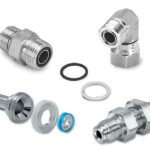Ergonomics, safety, efficiency, and refined quality are key themes for hydraulic hose applications these days. Machine builders are looking for hoses that improve service life and fit their exact specifications. Therefore, manufacturers are designing more durable and flexible hose solutions for heavy-duty mobile machines and evolving electro-hydraulic systems.

“A hose’s working pressure, flexibility, and lifetime are key selection criteria for original equipment manufacturers,” said Scott Bauman, product manager, rubber hydraulic hose and fittings, Danfoss Power Solutions.
Last year, Danfoss introduced a new two-wire braided hose that aims to extend service life and reduce maintenance time, costs, and waste. With higher pressure capabilities, the braided design can replace heavy, rigid four-wire spiral hose in certain applications, providing up to 30% direct cost savings. Braided hose is much more flexible than spiral hose, which may enable OEMs to reroute and reduce hose assembly lengths, contributing to further cost savings. Braided hose is also lighter in weight than spiral hose, which reduces the overall weight of the machine, improving fuel efficiency.
Speaking of fuel efficiency, Jeff Berger, product sales manager, alternative fuels, Parker Hannifin Corporation, noted that cleaner more sustainable energy solutions for off-road vehicles are slowly gaining momentum versus the traditional diesel-burning internal combustion engine (ICE). Two solutions under development are the battery electric vehicle (BEV) and hydrogen, either as a cleaner burning ICE or used in conjunction with a fuel cell electric vehicle (FCEV).
“When it comes to battery electric, the biggest changes we’re seeing are on the thermal management systems needed to regulate the temperature of the onboard batteries,” said Berger. “To increase the efficiency of the electric motors, inverters, and battery systems, the components are cooled with media choices such as water/glycol coolant solutions or direct refrigerant.”
Also, as the power source of equipment evolves from an ICE to battery technology, electro-hydraulic systems are trending over straight electrical solutions due to the power density required to operate the equipment efficiently.

“An advantage of using a variable speed electric motor over a traditional ICE is that we expect the hose life to be extended with this technology,” said Mark Schoessler, VP of sales and marketing for Parker’s motion systems group. “You are able to slow the ramp rate of the pressure curve created when the pump turns on by slowing the ramp rate on the electric motors to minimize the pressure shock placed on the hose and connections, thus helping our customers increase performance and service life of their equipment. Though we are not yet seeing a wide adoption to changes to the linear work functions of equipment’s hydraulic circuits or requirements, we are heavily investing in our future with our engineering teams preparing for an increased demand of electromechanical actuators (EMA).”
Mitch Eichler, sales manager for Parker’s fluid connectors group, also noted that customers value hoses that are easy to route and install, withstand a demanding service life, and fit into more compact spaces on smaller and more efficient equipment.
“In response to these customer needs, Parker has continued to invest in our Compact Spiral technology which produces hoses with smaller ODs, reduced bend radii and force to flex, and reduced weight,” said Eichler. “These advantages support an evolving workforce and align with environmental, social, and governance (ESG) focuses towards reduction in material and weight, as well as a reduction in energy demands. The latest in this development is the 777 series hose, released in 2022, rated for 4000 psi in accordance with ISO 18752.”
Parker is also releasing a new-to-world solution for impact resistance in hydraulic and industrial hoses. IFPE attendees can stop by booth S80229 in South Hall 3 to learn more about this new product.
In addition to hose design, as more of the industry moves toward electronic control, so too has the hose crimping machine. Hydraulic hose assembly equipment manufacturers continue to find new and creative ways to utilize Industry 4.0 concepts, and some have even produced semi-automated hose assembly stations. Many top crimp manufacturers offer high-end machines with touchscreen HMIs employing wireless links to the manufacturer database.
Just like the fluid power industry at large, crimping technology will continue to advance and become more versatile, productive, and easily maintained. For instance, machine builders can expect to see augmented reality identify the hose and fittings visually, such as with QR codes, then automatically populate crimp specifications.
At a higher level, there are ongoing shifts in hydraulic hose companies, with mergers and acquisitions potentially changing where hoses come from and expanding product offerings to customers. Plus, previously specialized companies are expanding and accumulating more specialized brands and targeting international customers, especially to give developing countries a leg up.
But as much as manufacturers join forces and refine their products, failures can still happen. Hose manufacturers are therefore emphasizing education to make sure their customers are knowledgeable about hose selection, installation, and maintenance to minimize failures and ensure long life.
And with the push for bigger, stronger, and faster machines, let’s not forget about the people interacting with and managing the equipment. Safety is a big push for making sure education and quality are synonymous, especially during field installation and maintenance, so that mobile machine personnel can replace parts quickly and safely on site.
Danfoss
danfoss.com
Parker Hannifin
parker.com






In regards to crimping machines getting more sophisticated and taking advantage of IoT4.0, Finn-Power is doing it now. Our IoT4.0 package will monitor hydraulic oil conditions and stream the data from the ICC control to a PC. The crimper is even smart enough to not Start if the oil level is below a certain threshold. The Premium control package can even detect a bad/faulty crimp IMMEDIATELY when certain predefined thresholds are breached. This can save a valuable hose or fitting by not damaging the fitting. This allows the operator fix the situation and go back to crimping. And, all crimp data (26 points of data) can be graphed and stored in the database. This database file can be exported to the network for archiving and reporting. The ICC control also has Qr code and any barcode capabilities. And, finally our auto-lubricant capability allows for 24/7 crimping without human intervention and without a loss accuracy.